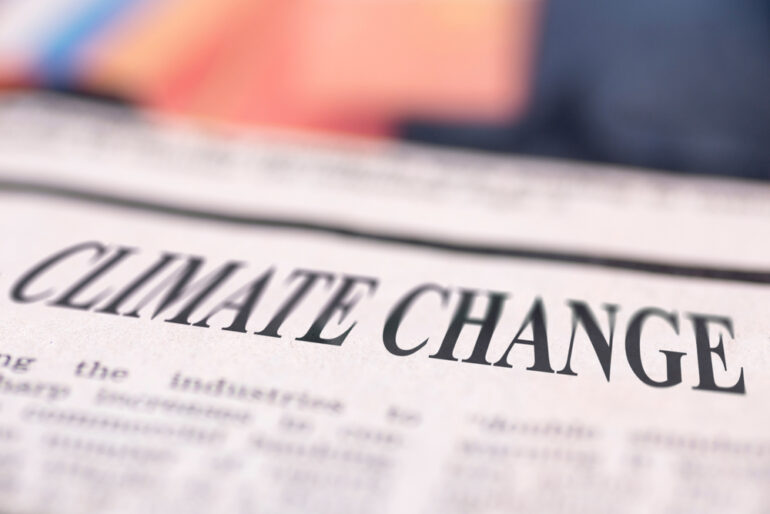🔴 Website 👉 https://u-s-news.com/
Telegram 👉 https://t.me/usnewscom_channel
The post Why the Media Keeps Getting It Wrong About Climate Change first appeared on USSA News | The Tea Party’s Front Page.. Visit USSANews.com.
Climate change is one of the most pressing issues of our time, yet the mainstream media continues to stumble in its coverage, leaving the public inadequately informed. At a time when every day brings news of intensifying natural disasters, rising temperatures, and shifting ecosystems, the role of media in shaping our understanding—and urgency—around climate action is vital. Yet, the reality is that many media outlets still aren’t giving this issue the spotlight it deserves.
While some publications have increased their climate coverage, they often fail to convey the scope of the crisis or the solutions that could help mitigate it. From downplaying the severity to avoiding uncomfortable truths about root causes, media coverage has often missed the mark.
A Missed Emergency: How Media Falls Short on Climate Change Coverage
The role of media in informing the public is crucial, yet, when it comes to climate change, many outlets have fallen short. Major television networks, in particular, provide strikingly little airtime to environmental issues. In fact, studies show that in 2022, ABC, NBC, CBS, and Fox devoted only about 1.3% of their coverage to climate-related news. This meager attention comes even as climate-related events, like record-breaking heat waves and wildfires, dominate headlines and affect millions of lives.
This lack of substantial coverage does more than leave viewers uninformed; it shapes public perception, leading many to believe that climate change isn’t as immediate or as severe as it truly is. When climate stories are only sporadically featured, the issue can appear more like a background concern than the urgent, all-encompassing crisis that experts warn it is. For many viewers, the infrequency of reporting means climate change isn’t a priority—if it were, they’d be hearing about it regularly, right?
Moreover, the missed opportunities are glaring. Consider extreme weather events that devastate communities and make international news—like the deadly heatwaves in Texas. Yet, during those moments, mainstream outlets mention climate change in only a fraction of segments. By failing to consistently make the connection between these events and the larger climate narrative, media outlets allow the crisis to fade into the background, delaying the public understanding and response we need.
The Influence of Fossil Fuel Industry Ads in Media
One of the most significant yet often overlooked factors in climate reporting is the influence of the fossil fuel industry itself. Fossil fuel companies have a longstanding history of running advertorials and native ads in reputable media outlets, creating content that subtly—and sometimes blatantly—casts them as part of the solution rather than a root cause of climate change. These ads often appear in high-profile publications, sitting right next to investigative pieces or environmental reporting, creating a confusing and contradictory message for readers.
This practice is no accident. Since the 1970s, fossil fuel companies have leveraged media placements to control the narrative around energy and environmental issues. Early pioneers of this tactic, like Exxon’s Herb Schmertz, pushed ads that shaped editorial stances, with the result being an industry-friendly tone on climate topics in reputable publications. Over decades, this strategy has only evolved, with fossil fuel companies spending billions on native ads that portray them as forward-thinking energy leaders. Meanwhile, in reality, fossil fuel giants like Exxon and Chevron invest only about 1% of their budgets in renewable energy or genuine climate solutions.
The impact of these ads is twofold. First, they subtly encourage the public to view fossil fuel companies as “partners” in climate action rather than major contributors to the crisis. Second, they compromise the trustworthiness of the media itself. Readers can’t always distinguish between journalism and paid content, and as a result, fossil fuel companies manage to present themselves in a positive light through what appears to be credible journalism. The end effect is public confusion, eroding the clarity of climate narratives and further delaying meaningful action.
Ethical Journalism vs. Financial Interests: A Conflict
The journalism industry is built on values like truth, independence, and accountability, which are essential when reporting on climate change. However, a conflict arises when financial interests—particularly in the form of fossil fuel advertising—undermine these values. Many media organizations continue to accept these lucrative ads despite knowing the influence they wield over public perception. This financial reliance not only compromises the integrity of journalism but also prevents these outlets from taking a firmer stand against industries that drive climate change.
Ethically, media outlets should act independently of special interests, especially when those interests run counter to public well-being. By accepting fossil fuel ads, these companies are, in effect, complicit in spreading disinformation that casts doubt on scientific consensus and promotes misleading “solutions” that slow climate progress. The Guardian and Vox Media have taken strong stances by cutting ties with the fossil fuel industry, demonstrating that a choice does exist, even if it comes with financial trade-offs.
For audiences, the repercussions are serious. It’s challenging to trust media coverage on climate when the same outlet may feature articles questioning fossil fuel practices one day and an ad from a fossil fuel company the next. If media companies were to fully embrace ethical journalism principles—focusing on independence and accountability—they could elevate climate discourse and provide the public with consistent, fact-based information that supports informed decision-making.
Beyond “Both Sides”: Misleading Narratives in Climate Reporting
Another critical flaw in climate coverage is the tendency for media to present “both sides” of the climate debate, even when the science overwhelmingly supports one side. This practice of “false balance” was especially pervasive in the early 2000s and remains an issue today. Media outlets often feature a climate scientist alongside a climate skeptic, giving both viewpoints equal weight and implying that there is legitimate debate among experts. In reality, over 99% of scientists agree that climate change is happening and is primarily driven by human activity.
This false equivalence undermines public understanding and trust in climate science. When media outlets frame the issue as a debate, they suggest to the audience that skepticism is scientifically valid, despite the overwhelming consensus among experts. This “both sides” narrative has a lasting impact: studies show that public belief in climate change has fluctuated in direct correlation with the amount of “balanced” reporting in the media. In contrast, other fields like public health and physics aren’t given the same “both sides” treatment. The result is a confused public, unsure of the facts and hesitant to support policy changes.
Moreover, climate reporting tends to overlook the experiences of those most affected by climate change. Voices from the Global South, where climate impacts are felt acutely, are often absent from mainstream media. The same can be said for climate activists who work tirelessly to bring attention to environmental justice issues but are frequently misrepresented or sidelined by the media. Amplifying these perspectives not only brings a fuller picture of the crisis but also respects the humanity and urgency behind the science.
The Path Forward: Solutions for Better Climate Reporting
For the media to help rather than hinder climate action, it must start treating the climate crisis with the urgency it deserves. This shift requires both a higher quantity of climate coverage and a focus on stories that emphasize real solutions. A primary recommendation is for media outlets to increase the frequency of climate stories to give the issue the consistent visibility it requires. Climate coverage should be as regular and intense as COVID-19 coverage was at its peak, serving as a clear message to the public that this is a top priority.
Another essential step is for media companies to reject fossil fuel advertising altogether. By doing so, they disentangle themselves from the influence of industries that actively work against climate solutions. Outlets like The Guardian and Vox Media have shown that this is possible, setting an example for others to follow. By removing these ads, media companies can commit to transparency and integrity in their reporting.
Finally, media should prioritize “solutions journalism,” reporting not just on the problem but on effective responses to the crisis. Stories that highlight renewable energy advancements, successful policies, and grassroots environmental movements help empower readers to take action within their own communities. This shift also promotes a sense of agency and hope, showing that progress is achievable and that individuals have a role in it. When people see viable paths forward, they’re more likely to engage, support, and advocate for the policies needed to address climate change.
Turning the Tide on Climate Coverage
As the climate crisis continues to intensify, the media’s role in shaping public perception and action has never been more critical. The narratives presented in news outlets influence how people understand the urgency of climate issues, the solutions available, and the changes needed to secure a livable future. Yet, by giving minimal airtime to the crisis, entertaining “both sides” of a settled debate, and allowing fossil fuel interests to weave their messages into coverage, the media risks stalling the action required to mitigate climate change.
To turn the tide, media organizations must recommit to the principles of ethical journalism by delivering honest, clear, and solution-oriented climate coverage. Rejecting fossil fuel advertising, amplifying underrepresented voices, and treating climate news with the same urgency as other global crises are essential steps forward. When audiences are consistently informed, they gain the clarity needed to make environmentally conscious decisions, support sustainable policies, and push for systemic change.
The future of climate journalism hinges on these efforts, and we all play a part in making it happen. By supporting outlets that prioritize transparent climate reporting, holding media accountable for misleading narratives, and demanding that the climate crisis takes center stage, we can foster a better-informed public and a stronger momentum for change. A shift in climate coverage can help turn awareness into action, driving the steps needed for a more sustainable future.
Click this link for the original source of this article.
Author: The Mind Unleashed
This content is courtesy of, and owned and copyrighted by, https://themindunleashed.com and its author. This content is made available by use of the public RSS feed offered by the host site and is used for educational purposes only. If you are the author or represent the host site and would like this content removed now and in the future, please contact USSANews.com using the email address in the Contact page found in the website menu.
The post Why the Media Keeps Getting It Wrong About Climate Change first appeared on USSA News | The Tea Party’s Front Page.. Visit USSANews.com.
Source link

